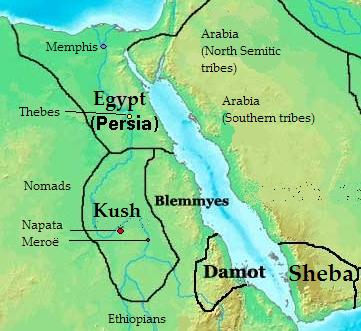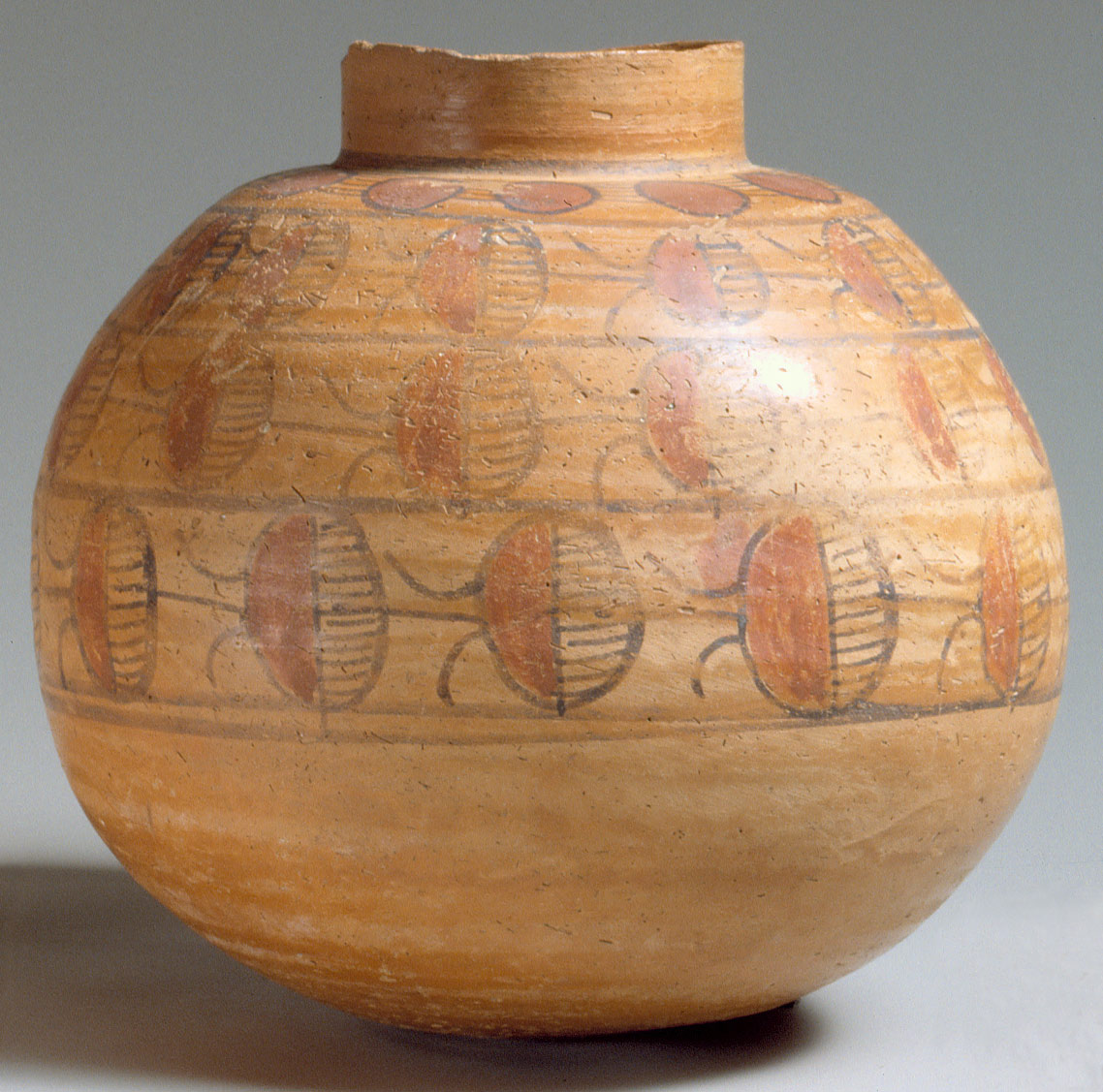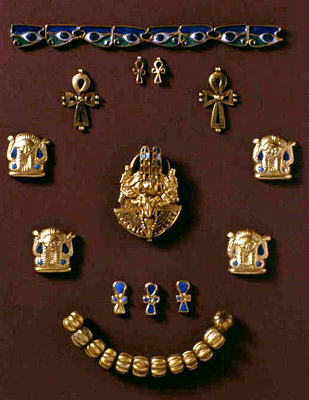Geography
 Meroë is located on the east bank of the Nile River in Sudan. The city of Meroë was the center of Nubian civilization during the classical era. Most of Sudan is a vast featureless plain, except for in the east and west where there are mountains. It is dominated by the Nile and its tributaries.
Meroë is located on the east bank of the Nile River in Sudan. The city of Meroë was the center of Nubian civilization during the classical era. Most of Sudan is a vast featureless plain, except for in the east and west where there are mountains. It is dominated by the Nile and its tributaries.
Sources: http://en.wikipedia.org/wiki/Meroë, http://en.wikipedia.org/wiki/Kingdom_of_Kush, http://workmall.com/wfb2001/sudan/sudan_geography.html, Ways of the World: A Global History with Sources by Robert W. Strayer (Pg. 284-86).
Religion & Beliefs
Religion in Meroë was polytheistic. It had clear beginnings in Egyption belief, sharing gods such as Isis, Amun, Horas, and Bas. They also had their own dieties. Meroë used pyramids as burial sites. These pyramids were commonly built over tombs containing bodies that were either burned or not mummified.
Sources: http://en.wikipedia.org/wiki/Meroë, http://suite101.com/article/meroitic-beliefs-and-religion-a196549, http://en.wikipedia.org/wiki/File:Sudan_Meroe_Pyramids_30sep2005_2.jpg
Arts
Meroë was very wealthy in gold, and had a lot of exports in jewelry and textiles. They also made statues of their dieties,



Sources: http://www.egyptsearch.com/forums/ultimatebb.cgi?ubb=get_topic;f=8;t=006932, http://www.metmuseum.org/toah/works-of-art/08.202.47, http://www.rom.on.ca/exhibitions/wculture/nubia.php, http://vigilantcitizen.com/vcboards/viewtopic.php?f=17&t=8418&sid=fa99343366270b5b24d094d3e6ad6ecb&view=print
Social Development
The cities of the Nile, including Meroë, were patriarchal societies. Peasants and Slaves contributed most of the labor, and individuals had the opportunity to gain a higher role in society through their professions. Wealthy and powerful people had elaborate tombs built for them-- the common people did not.
Sources: http://apworldhistorywiki.wikispaces.com/Egypt+%28complex%29+%2869-80%29+2
Politics
Meroë had an all-powerful religious monarch, who was occasionally female. Although rulers were all powerful, historians believe that there was a "greater element of consent by the people" than ever before seen in Egypt. Monarchs came from a single royal family, but inheritance of power was not automatic; it required "agreement of nobility and the final approval of the priesthood." The mother of the ruler also had a lot of influence. Rulers were buried along with many human sacrificial victims.
Sources: l, The Ways of the World: A Global History with Sources by Robert W. Strayer (Pgs. 284-86).
Economics
The city of Meroë had specialized workers such as merchants, weavers, potters, and masons. Meroë had extensive trading connections via the Nile and camel caravans. Main exports came from mining and hunting. both of these activities were under direct control of the king. Farmers did not have to depend on irrigation from the Nile because of the dependable rain season, so they were able to spread out more and be more profitable. They were also under less direct control from the government.
Sources:
Demographics
The population of Meroë was mainly made up of cattle-herders and "peasant cultivators." They lived in houses made of mud and reeds that were grouped in small villages and ruled over by local chiefs or family clans. They were not under very strict government control and "probably paid their taxes in the form of annual tribute to the king." Herders were semi-nomadic.
Sources: http://wysinger.homestead.com/nubianpolitics.htm
Intellectual Development
Although the Kingdom of Meroë originally had much Egyptian influence, as seen by their shared gods and writing systems, they slowly began to draw away from Egyptian culture. Besides creating and worshiping their own gods, they also formulated their own system of writing, which is still undeciphered.
Sources: The Ways of the World: A Global History with Sources by Robert W. Strayer (Pgs. 284-86)
Technology
The most prominent industries in Meroë's civilization was the smelting of iron and the manufacture of iron tools and weapons. The area around Meroë was full of fuel for the fires that were used in this iron technology.
Sources: The Ways of the World: A Global History with Sources by Robert W. Strayer (Pgs. 284-86), http://www.allempires.com/article/index.php?q=Iron_age_Meroe


Regarding demography, about how many people lived under the rule of this empire? Hundreds, thousands?
ReplyDeleteI can't seem to find an exact number, or even a ball park number! I'll keep looking, but so far all I've found is that it as a "large" population.
DeleteGreat use of visuals and information! I’m curious, what do you think caused the strong patriarchal society? This is just an observation that I found really interesting and I’m really glad you included, it was a patriarchal society but mothers of leaders had a lot of influence. That’s an interesting contrast to think about.
ReplyDeleteI completely agree, it's very interesting that a patriarchal society would have occasional female rulers and also hold respect for the mothers of leaders. I wonder if this happened in other patriarchies? I think it did in China, where women gained respect with age.
DeleteI found all of this interesting as well. I would imagine the patriarchy was developed for the same reasons others were -- as work such as agriculture began to move away from the home, women could not follow because of their duties as mothers, which led into their duties as housekeepers or "homemakers" and so on.
DeleteVery informational, btw very clean and clear blog. Makes it easy to read(: My only question to you is for the demographics were women also cattle-herders? If not, what role did they take on in the Meroe civilization?
ReplyDeleteHere's what I found:
Deletewomen worked alongside men in the fields in addition to caring for the home and children. During times of war, women would go to battle alongside men as well.
"Women in Kush could become priestesses and even Queens. King Piankhi made his sister a priestess. Many royal families followed suit and named their daughter princesses, priestesses as well. Some women were co-rulers with their husbands and sons such as Queen Shanakdakheto (Shah-nahk-dah-kee-toh). Queen Shanakdakheto ruled the kindom alone from 170-150 B.C. Historians believe that she became ruler after her husband or father died."
Very interesting, especially since it seems to definitely contradict what I said about patriarchy... Hmmm... Must look into that more :)
WU TANG! Anyways, since to the east and the west of them was mountainous, did it affect their trade routes or economy at all? Or did they just mostly travel down the Nile for means of trade and transportation.
ReplyDeleteI *believe* that most of their trading was done with Egypt, since that was the largest civilization that was in close proximity... So I'm guessing most of their trade was done on the Nile. That's what it looked like when I looked up maps of trade routes... Of course, this is more guesswork than fact, so feel free to contradict me!
DeleteI'm not sure if I'm just overlooking something, but what was the span of this civilization? I found this really interesting!
ReplyDeleteThe internet says 270 BCE - 370 CE :)
DeleteWas there ever any battles or wars that occurred with the Meroe and Egypt?
ReplyDeleteMeroe originated from the Kush Empire, and Kush and Egypt had many power tug of wars for a while, but before Meroe started playing such a big role. I couldn't find anything about war or conflict between Meroe and Egypt. They were very connected by trade, and Meroe had a lot of Egyptian influence, especially at first, as seen in such areas as religion
DeleteHave historians figured out or identified a specific religion unique to the Meroe people(like a name or certain deities), or have they only found the shared religious practices(such as Iris)?
ReplyDeleteThere are some deities that are considered unique to Meroe or Nubia, such as Apedemak
DeleteWhat were some deities that were unique to Meroë?
ReplyDeleteApedemak is an example of a deity that is unique to Monroe. I think Amon was also a unique god.
Delete